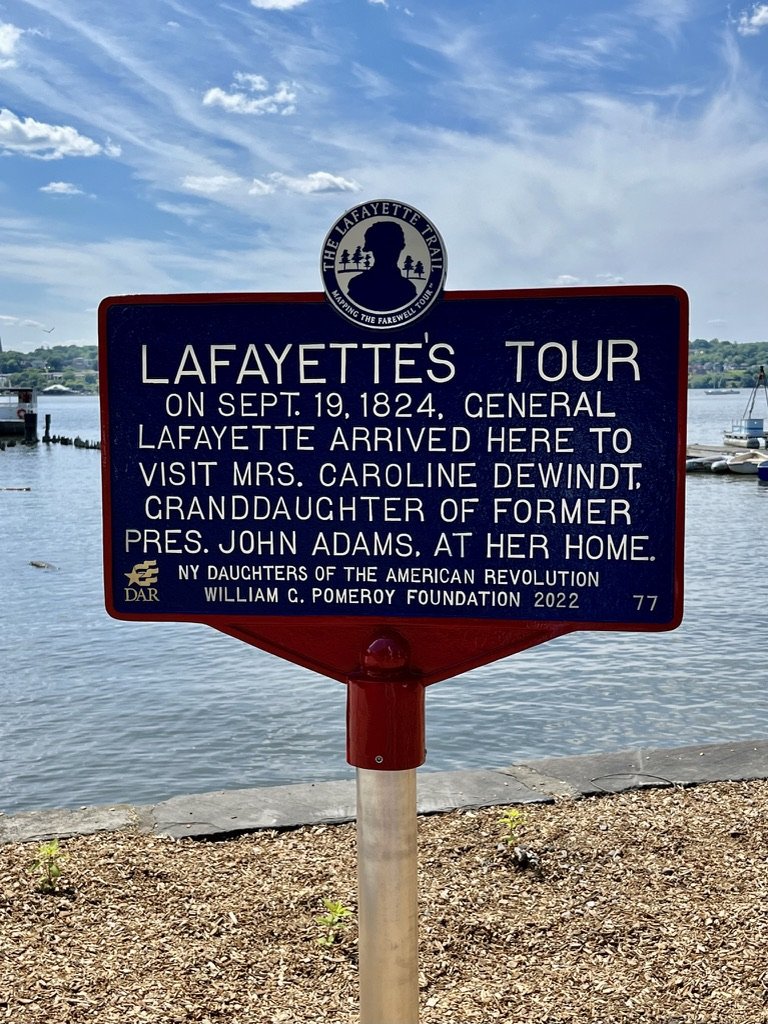Lafayette's 1824 Farewell Tour of the United States - Marker Dedication
General Lafayette engraving by Jean Marie Leroux from 1824. Collection of the Beacon Historical Society.
A commemorative marker was placed on Beacon’s riverfront on June 6, 2022 to honor the Marquis de Lafayette’s visit to Fishkill Landing in 1824. Who was Lafayette and why was his visit here important? In 1777, Lafayette at age 19 came from France to volunteer and fight in the Continental Army alongside George Washington in the struggle for American independence. Not only did he demonstrate great leadership, he risked his life, used his own fortune and his influence in France to garner additional support. He fought in the Battle of Brandywine in Pennsylvania and the Siege of Yorktown in Virginia.
Fifty years later, he was invited by president James Monroe to tour the US, to instill the “spirit of 1776” and help celebrate the nation’s 50th anniversary. Traveling by stagecoach, horseback, canal barge, and steamboat, Lafayette visited twenty-four states (over 6,000 miles) to a hero’s welcome. As the last surviving General of the war, Lafayette was welcomed and celebrated wherever he went… with parades, artillery salutes, dinners, and dances. On September 19, 1824, the Marquis stopped in Fishkill Landing (now Beacon) to visit Caroline Amelia Smith DeWindt, granddaughter of second president John Adams. Lafayette, Adams and Caroline’s father Capt. William Smith were allies during the war.
When visiting Fishkill Landing, the Evening Post described the meeting, “On reaching the house, the General and suite were ushered into a room brilliantly lighted and decorated with portraits of Col. Smith and lady, and a bust of President Adams. He was here received by Mrs. Dewindt. Fruit and wines and other refreshments having been handed to the company.” In the Historical Society’s collections, a letter written by Caroline to her friend Harriet Welsh recounts her visit a few days prior with the General while in lower Manhattan. “He (Lafayette) kissed my hand and expressed himself gratified at seeing me.”
Carolyn’s husband Peter DeWindt was a wealthy entrepreneur who invested in steamboats and railroads in the mid 1800s. He owned most of what is now Beacon, built Long Dock, and donated land for the Dutch Reformed Church, which was designed by one of his sons-in-law Frederick Clarke Withers. DeWindt's home Cedar Grove in Fishkill Landing was known as a center of culture, and hosted political leaders, poets, and celebrated artists of the time. It burned in 1857. Caroline, along with another son-in-law Andrew Jackson Downing (a prominent landscape designer and writer) died in a deadly fire aboard the steamboat Henry Clay in 1852.
The Lafayette marker is located across the street from the train station on Red Flynn Drive in Beacon NY.
The Lafayette marker project is the brainchild of Julien Icher, president of the Lafayette Trail, whose aim is to educate the public about the national significance of Lafayette’s Farewell Tour and to promote a broader understanding of his numerous contributions to American independence. The marker was donated by the Pomeroy Foundation in collaboration with the New York State and Melzingah Chapters of the Daughters of the American Revolution, and in conjunction with the City of Beacon, and volunteers and City Council members who planted a pollinator-friendly garden around the historic marker. The Beacon Historical Society hosted a lecture by Icher at the Beacon High School Theater.


